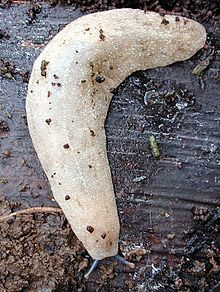| Veronicella sloanii | |
|---|---|

| |
| A live individual of Veronicella sloanii, head end towards the bottom of the image | |
| Scientific classification | |
| Domain: | Eukaryota |
| Kingdom: | Animalia |
| Phylum: | Mollusca |
| Class: | Gastropoda |
| Order: | Systellommatophora |
| Family: | Veronicellidae |
| Genus: | Veronicella |
| Species: | V. sloanii |
| Binomial name | |
| Veronicella sloanii (Cuvier, 1817) | |
| Synonyms | |
| |
Veronicella sloanii, commonly called the pancake slug, is a species of air-breathing land slug, a terrestrial, pulmonate gastropod mollusk in the family Veronicellidae, the leatherleaf slugs.
Description
When extended, this slug can attain a length of 12 cm (5 in.). It is highly variable in coloration and positive identification depends on dissection and inspection of the genitalia. It is usually very pale in color, ranging from mottle pale yellow, cream to white. It may have irregular black spotting or speckling all over the dorsal surface that may coalesce into two poorly defined bands running down either side of the body; in the juveniles, these two bands may be clearer and better defined as grey bands, especially anteriorly. Occasionally the slug can be mostly brownish. The only constant color character among different Caribbean island populations is the eye stalk, which is bluish grey with a light brown tip.
Distribution
The indigenous distribution of Veronicella sloanii is Jamaica. The type locality is in Jamaica.
Other non-indigenous distribution includes:
- Barbados
- Bermuda
- Dominica - first report from Dominica in 2009
- Dominican Republic
- Saint Lucia
- Saint Vincent
- Cuba (Bahia Honda in Pinar del Río Province).
This slug has been introduced to Florida and it has become an agricultural pest there.
Controversially Cowie et al. (2009) considered this species has not yet become established in the US, but it is considered to represent a potentially serious threat as a pest, an invasive species which could negatively affect agriculture, natural ecosystems, human health or commerce. Therefore, it has been suggested that this species be given top national quarantine significance in the USA.
Ecology
Habitat
This slug lives in moist conditions and is nocturnal.
The best times to hunt for the slug is after rainfall. They rest under boards, logs and other objects lying on the ground.
Feeding habits
This species attacks a wide variety of agricultural and horticultural plants including banana, plantain, various beans and peas, peanut, eggplant, cultivars of Brassica (e.g., broccoli, cabbage, cauliflower), carrot, hot and sweet peppers, various citrus species, lettuce, sweet potato, dasheen, eddoe, tannia, tomato, and yam.
Life cycle
The slug lays a clutch of about 30 eggs, which are about 5 mm in diameter. The hatching time in captivity was 15 days at 24 °C.
Importance for humans
This species is an agricultural pest.
They should not be handled with bare hands because they serve as intermediate hosts of the nematode Angiostrongylus costaricensis, which causes a disease called human abdominal angiostrongyliasis.
References
This article incorporates public text a public domain work of the United States Government from the reference
- (in French) Cuvier G. (1817). Le règne animal distribué d'après son organisation, pour servir de base à l'histoire naturelle des animaux et d'introduction à l'anatomie comparée. Tome II, contenant les reptiles, les poissons, les mollusques et les annélides. Déterville, Paris, France. https://biodiversitylibrary.org/page/1849261
- ^ Maceira D. F. (2003). "Las especies de la familia Veronicellidae (Mollusca, Soleolifera) en Cuba". Revista de Biología Tropical 51(3): 453-461. PDF Archived 28 July 2007 at the Wayback Machine.
- ^ Robinson D. G., Hovestadt A., Fields A. & Breure A. S. H. (July 2009). "The land Mollusca of Dominica (Lesser Antilles), with notes on some enigmatic or rare species". Zoologische Mededelingen 83 http://www.zoologischemededelingen.nl/83/nr03/a13
- Clarke N. & Fields A. (2013). "Mating in Veronicella sloanii (Cuvier, 1817) (Veronicellidae)". American Malacological Bulletin 31: 235-244. doi:10.4003/006.031.0203.
- ^
 Stange L. A. (created September 2004, updated March 2006). "Snails and Slugs of Regulatory Significance to Florida". Division of Plant Industry, Florida Department of Agriculture and Consumer Services. accessed 27 August 2010.
Stange L. A. (created September 2004, updated March 2006). "Snails and Slugs of Regulatory Significance to Florida". Division of Plant Industry, Florida Department of Agriculture and Consumer Services. accessed 27 August 2010.
- Rosenberg G. & Muratov I. (2003-2005). Distribution of non-endemic species of terrestrial mollusks from Jamaica. Published May 2003, modified 5 August 2005, accessed 27 October 2008.
- ^ Cowie R. H., Dillon R. T., Robinson D. G. & Smith J. W. (2009). "Alien non-marine snails and slugs of priority quarantine importance in the United States: A preliminary risk assessment". American Malacological Bulletin 27: 113-132. PDF Archived 16 June 2016 at the Wayback Machine.
- ^ Anonymous. (2005) "Veronicella (Veronicella) sloanei (Cuvier, 1817) Pancake Slug". PetSnails.co.uk. Accessed 27 October 2008.
- "Terrestrial slugs of Florida". Institute of Food and Agricultural Sciences and University of Florida. June 2011.
Further reading
- (in Italian) Quattrini D. & Lanza B. (15 December 1968). "Observations on the gonads of Veronicella sloanei (Cuvier) (Gastropoda soleolifera veronicellidae)". Boll Soc Ital Biol Sper. 44(23): 2023-2026.
External links
| Taxon identifiers | |
|---|---|
| Veronicella sloanii | |